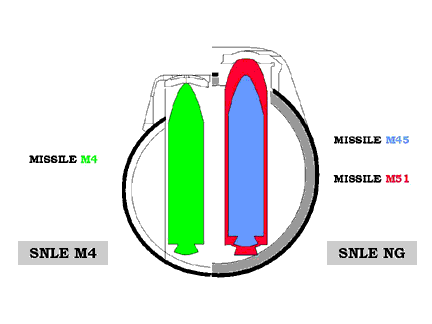





In 1992 the French defense ministry launched the development of the new generation MSBS, the M-5. This continues the tradition of improvements in the MSBS system since 1971, when the first system, M-1, entered service.
The latest development of the MSBS (Mer-Sol-Balistique-Strategique) family will be the M-5 SLBM planned for the seventh French SSBN Le Triomphant, which entered service in 1995, and will be the first of four new SSBN known in France as the SNLE-NG (Sous-marines Nucleaire Lanceur d'Engins Balistique - Nouvelle Generation). The first boats are expected to carry the improved M-45 variant SLBM, until the M-5 becomes available in 2010. The `Le Triomphant' submarines are fitted with 16 SLBM launch tubes. Full-scale development of M-5 was scheduled to start in 1993. A proposal was made to develop a land-based version for location in the Plateau d'Albion as a replacement for the S-3 missiles, with up to 10 land-based M-5 missiles (known as S-5) located in the S-3 silos, but this proposal was cancelled in 1993 in favor of adapting the existing M-4 design.
The three stage solid propellant M-5 missile is to have a range of 11000 km, together with modern penetration aids capable of matching the perceived upgrades to the Moscow anti-ballistic missile system. It is believed that the missile will be around 12.0 m long, with a body diameter of 2.3 m and a launch weight of 48000 kg. The payload has been reported as being between 6 to 10 MIRV using the TN 76 nuclear warhead with an expected yield of 100 kT. It is expected that penetration aids will be carried.
The M-5 missile was planned for introduction into service in 2010 as a replacement for the M-4 and M-45 SLBM, with full-scale development scheduled to start in 1993.
In February 1996 the President of France confirmed the pursuit of the program with certain changes in specifications to conform with budgetary constraints. The new missile, the M-51, will none-the-less, conserve the essential characteristics planned for the M-5. Falling under the concept of strict sufficiency, this program was reorientated towards the version M 51, whose range will be about 6,000 kilometers and who will be able to carry from 2015 of the nuclear heads of new generation (TNO).
The M51 system is destined to arm the SNLE-NG from the year 2010. The M51 missiles have a range of around 6,000 km and cost 32.7 billion francs to develop rather than 42 billion for the M5. This saving comes at the cost of a reduced range. The M5 was to be able to carry a 1,400 kg payload to a range of 6,000 km or a 200 kg as far as 14,000 km, in the latter case with one or two rather than six nuclear warheads.
The M-51 is a three-stage missile with a total mass of over 50 tonnes (compared to 35 for the M4). The stages use solid propulsion and are equipped with flexible nozzles. Their structures are made by filament winding of carbon fiber/epoxy material. The system takes the evolution of the threat, and new types of defenses into account. The M-51 missile will have multiple warheads. The volume and mass available for the payload (nuclear warheads and pen-aides) are greatly superior to the M4. Range, significantly higher than 5000 km, will among other advantages, extending the patrol area of the submarine fleet.

Specifications |
||
| prime contractor | Aerospatiale, Space and Strategic Systems Division, Les Mureaux | |
| Version | M-5 | M-51 |
| Length | 12.0 m | |
| Body diameter | 2.3 m | |
| Launch weight | 48000 kg | ? 50,000 kg |
| Payload | 6-10 MIRV | |
| Warhead | Nuclear 100 kT each | |
| Guidance | Inertial | |
| Propulsion | 3 stage solid | |
| Range | 11,000 km | 6,000 km |
| Accuracy | n/k | |

